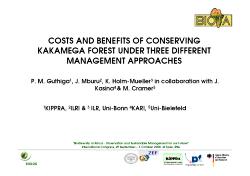|
|
|
 |
|
|
Presentation
< back to presentation overview
| Details of the presentation |
| Presentation |
Oral presentation |
| Title |
Cost-benefit analysis of different management approaches of Kakamega Forest in Kenya
|
| PDF Download |
 Download PDF (Filesize 10.9 MB)
Download PDF (Filesize 10.9 MB)

|
| Short title |
Kakamega Forest Cost-Benefit Analysis
|
| Author(s) |
Guthiga, P. (1) Holm-Mueller, K. (2) Mburu, John (3) Kasina, J (4), Kramer, M (5)
|
| Presenting author |
Guthiga, P.
|
| Institution(s) |
(1) Kenya Institute for Public Policy Research and Analysis (KIPPRA), Nairobi; (2) Institute for Food and Resource Economics, University of Bonn; (3) International Livestock Research Institute (ILRI), Nairobi; (4) Kenya Agricultural Research Institute (KARI), Nairobi; (5) Bielefeld University, Germany
|
| Keywords |
Economic efficiency; Forest management approaches; Cost-benefit analysis; Kakamega Forest; Kenya
|
| Abstract |
Kakamega forest, the only tropical rainforest in Kenya is divided into three different parts each under a distinct management approach: a state-led incentive-based approach of the Forest department (FD), a privately-owned incentive-based approach of a local Quakers church mission (QCM) and a state-led protectionist approach of the Kenya Wildlife Service (KWS). Since conservation involves use of resources and distribution of resulting benefits, economic concerns require that resources be allocated in a way that generates maximum net benefits. In addition, understanding the distribution of costs and benefits of conservation among stakeholders is important for informing equity decisions. The study applied the framework of cost-benefit analysis to analyze the economic efficiency and to compare the distribution of costs and benefits among stakeholders under the three management approaches at the local, national and global levels. The results indicate that from a global point of view, the three management approaches are economically efficient. However, from the local and national perspective, the opportunity costs of conserving the forest outweigh the benefits under FD and KWS. QCM management was efficient at local and national level but at the expense of conservation. To correct the skewed burden of conservation costs, appropriate compensatory mechanisms are needed.
|
| Congress Topic |
Land use, impact and value
|
| Topic No. |
3.7 |
| Notes |
---
|
| Ref. No. |
630 |
|
|
|
